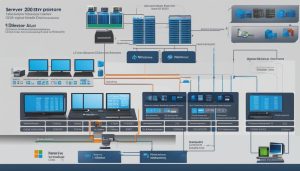User Account Control (UAC) is a vital Windows security feature that safeguards the operating system from unauthorized modifications. It functions by notifying users when changes requiring administrator-level permission are about to be made, granting them the ability to approve or deny the modification. By limiting the execution of malicious code with administrator privileges, UAC enhances the security of Windows devices, empowering users to make informed decisions regarding actions that may impact their device’s stability and security. UAC is enabled by default and can be customized by users with administrative privileges, preventing malicious software from tampering with UAC settings.
Key Takeaways:
- UAC is a Windows security feature that protects against unauthorized changes.
- It notifies users when administrative-level permission is required for a modification.
- UAC limits the execution of malicious code with administrator privileges.
- It allows users to make informed decisions regarding device security.
- UAC is enabled by default and can be customized by administrators.
Benefits of UAC
User Account Control (UAC) offers a range of benefits that contribute to the overall security and protection of Windows devices. By understanding these advantages, users can make informed decisions and utilize UAC effectively.
1. Enhanced Security
One of the primary benefits of UAC is its ability to enhance security by limiting the access rights of standard user accounts. When a standard user attempts to perform an action that requires administrative privileges, UAC triggers a consent prompt. This grants users control over the action, allowing them to approve or deny it. With UAC enabled, unauthorized changes and potential malware attacks are prevented, providing an added layer of security to the device.
2. Access Control and Privilege Separation
Through UAC, users can sign in to their Windows devices using a standard user account. This ensures that applications and processes run with limited privileges, reducing the risk of unauthorized system modifications. When administrative privileges are required, UAC prompts the user for consent, preventing unauthorized actions while still allowing the necessary tasks to be performed. This privilege separation ensures that actions requiring elevated permissions are only performed with explicit user approval.
3. Improved User Experience
UAC greatly improves the user experience by providing clear notifications and prompts when administrative actions are required. These prompts are color-coded, making it easier for users to identify potential security risks. By directing elevation prompts to the secure desktop, UAC creates a seamless and secure environment for users to make decisions regarding administrative tasks. This not only enhances the security of the device but also ensures that users have a smooth and informed experience when interacting with their Windows device.
In summary, UAC offers several benefits that contribute to the security and usability of Windows devices. By limiting unauthorized access, providing control over administrative actions, and improving the user experience, UAC plays a crucial role in maintaining the stability and security of Windows devices.
Windows Editions and Licensing Requirements
User Account Control (UAC) is not only a vital security feature but also a crucial consideration when choosing the appropriate Windows edition and understanding the licensing requirements. Different Windows editions have varying levels of UAC support and entitlements. It is essential to align your choice of Windows edition with your UAC implementation strategy.
Windows Editions with UAC Support
UAC is supported in various Windows editions, including:
- Windows Pro
- Windows Enterprise
- Windows Pro Education/SE
- Windows Education
Each of these editions offers distinct features and advantages, catering to different user requirements and organizational needs. Understanding the specific UAC support in each edition is crucial for a successful implementation.
Licensing Requirements
When it comes to UAC licensing requirements, it’s important to consider the following:
| Windows Edition | UAC License Entitlements |
|---|---|
| Windows Pro / Pro Education / SE | UAC entitlement included |
| Windows Enterprise E3 / E5 | UAC entitlement included |
| Windows Education A3 / A5 | UAC entitlement included |
These licensing requirements ensure that users have the necessary permissions and access levels to effectively utilize UAC in their Windows environment. It is crucial to align your licensing agreements with the desired UAC capabilities.
By considering the Windows editions and licensing requirements, you can ensure that your organization’s UAC implementation meets both security needs and compliance obligations.
How UAC Works and Interactions
User Account Control (UAC) follows a specific process to ensure the security and integrity of Windows devices. When an application requires administrative privileges, UAC prompts the user for consent through a consent prompt. This prompt is designed to notify the user about the potential security risks associated with the action. The user can then approve or deny the action based on their judgment. UAC also employs color-coded elevation prompts, which make it easier for users to identify the potential security risk of an application.
The user experience with UAC differs between standard users and administrators. Standard users are presented with a credential prompt that requires them to provide the appropriate administrative credentials to proceed. On the other hand, administrators are presented with a consent prompt that allows them to approve or deny the action. The elevation process is further secured by directing the prompt to the secure desktop, preventing any potentially malicious applications from intercepting or manipulating the prompt.
UAC interactions also involve the assignment of integrity levels to processes. Each application that requires the administrator access token must prompt the user for consent, except for child processes inheriting the user’s access token. Windows assigns integrity levels to processes, determining their level of trust. This ensures that processes with lower integrity levels cannot interfere with processes with higher integrity levels. By enforcing these interactions and security measures, UAC helps protect Windows devices against unauthorized changes and potential security threats.
Table: UAC Process and Interactions
| Process | Description |
|---|---|
| Prompt for Consent | When an application requires administrative privileges, UAC prompts the user for consent through a consent prompt. The user can then approve or deny the action. |
| Color-Coded Elevation Prompts | UAC uses color-coded elevation prompts to indicate the potential security risk of an application, making it easier for users to make informed decisions. |
| Credential Prompt | Standard users are presented with a credential prompt that requires them to provide the appropriate administrative credentials to proceed with the action. |
| Consent Prompt | Administrators are presented with a consent prompt that allows them to approve or deny the action requiring administrative privileges. |
| Secure Desktop | The elevation process is directed to the secure desktop, preventing potentially malicious applications from intercepting or manipulating the prompt. |
| Process Integrity Levels | Windows assigns integrity levels to processes, ensuring that processes with lower integrity cannot interfere with those with higher integrity. |
By implementing these processes and interactions, UAC helps maintain the security of Windows devices by preventing unauthorized changes and limiting the execution of malicious code with administrator privileges. It empowers users to make informed decisions about actions that may affect the stability and security of their devices, enhancing overall device security.
Conclusion
User Account Control (UAC) serves as a vital component in fortifying the security of Windows devices. By preventing unauthorized changes and limiting the execution of malicious code with administrative privileges, UAC ensures the integrity and safety of your system.
To maximize the security of your device and shield it against malware attacks, it is strongly recommended to enable and utilize UAC. This security feature grants users the authority to approve or deny actions that require administrative privileges, empowering them to make informed decisions and maintain the stability of their devices.
Regardless of your technical expertise, it is crucial to recognize the importance of UAC and the inherent risks associated with disabling it. By keeping UAC active, you enhance the overall security of your system and safeguard your data from potential threats.
FAQ
What is User Account Control (UAC)?
User Account Control (UAC) is a Windows security feature designed to protect the operating system from unauthorized changes. It notifies the user when changes requiring administrator-level permission are about to be made, giving them the opportunity to approve or deny the change.
What are the benefits of UAC?
UAC improves the security of Windows devices by limiting the access that malicious code has to execute with administrator privileges. It allows users to make informed decisions about actions that may affect the stability and security of their device.
Which Windows editions support UAC?
UAC is supported in various Windows editions, including Windows Pro, Windows Enterprise, Windows Pro Education/SE, and Windows Education.
How does UAC work and interact with applications?
With UAC, each application that requires the administrator access token must prompt the user for consent, unless it is a child process inheriting the user’s access token from a parent process. Windows protects processes by assigning them integrity levels, which determine their level of trust. UAC prompts the user for approval when an app requires administrative privileges.
Why is UAC important?
UAC plays a crucial role in enhancing Windows security by preventing unauthorized changes and limiting the access that malicious code has to execute with administrator privileges. It is recommended to enable and use UAC to maximize the security of your device and protect against malware attacks.
Janina is a senior specialist in information technology


